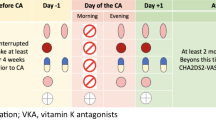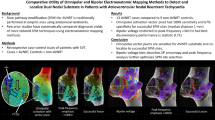Abstract
Background
This study aims to evaluate the prevalence, clinical characteristics, electrophysiological mechanisms, and long-term outcomes of right atrial tachycardia (AT) in patients who underwent ablation for atrial fibrillation (AF).
Methods
From March 2010 to December 2020, 220 consecutive patients undergoing index AF ablation were referred for post-ablation AT recurrence. Thirty-five patients (35/220, 15.9%) with right AT recurrence (25 men; mean age 59.3 ± 10.2 years) were enrolled. These patients were divided into groups with right ATs exclusively (group 1) and right combined with left ATs (group 2).
Results
Fifty-three ATs were mapped in all patients, with thirty-nine ATs originating from the right atrium. The detailed distribution of all right ATs was 22 in the cavo-tricuspid isthmus (CTI), 6 in the ostium of superior vein cava (SVC), 4 in the right free wall, 4 in the right anterior atrial septum, 2 in coronary sinus ostium, and 1 in crista terminalis. Group 2 had a significantly higher incidence of typical atrial flutter (AFL) than group 1 (11/12, 90.9% vs. 12/24, 50.0%, P = 0.03). During the mean follow-up of 43.6 ± 25.2 months after the index AT ablation, the recurrence rate of AT/AF was 22.9% (8/35), and it was lower in group 1 than in group 2 (8.3% vs. 54.5%, P = 0.01).
Conclusion
Right AT is relatively less common post-AF ablation. The CTI-dependent AFL and the ostium of SVC-derived focal AT constituted the major components of right ATs, suggesting the importance of ablation- and anatomy-related arrhythmogenic effects in the right atrium.




Similar content being viewed by others
Data Availability
Data available on request from the authors.
Abbreviations
- AT:
-
Atrial tachycardia
- AF:
-
Atrial fibrillation
- AFL:
-
Atrial flutter
- CFE:
-
Complex fractionated electrogram
- CPVI:
-
Pulmonary vein isolation
- CSO:
-
Coronary sinus ostium
- CT:
-
Crista terminalis
- CTI:
-
Cavo-tricuspid isthmus
- ECG:
-
Electrocardiogram
- LA:
-
Left atrium
- LAD:
-
Left atrial diameter
- LPV:
-
Left pulmonary vein
- MI:
-
Mitral isthmus
- NSR:
-
Sinus rhythm
- PVs:
-
Pulmonary veins
- RA:
-
Right atrium
- RFW:
-
Right free wall
- SVC:
-
Superior vein cava
References
Oral H, Pappone C, Chugh A, Good E, Bogun F, Pelosi F Jr, et al. Circumferential pulmonary-vein ablation for chronic atrial fibrillation. N Engl J Med. 2006;354(9):934–41.
Chae S, Oral H, Good E, Dey S, Wimmer A, Crawford T, et al. Atrial tachycardia after circumferential pulmonary vein ablation of atrial fibrillation: mechanistic insights, results of catheter ablation, and risk factors for recurrence. J Am Coll Cardiol. 2007;50(18):1781–7.
Satomi K, Bansch D, Tilz R, Chun J, Ernst S, Antz M, et al. Left atrial and pulmonary vein macroreentrant tachycardia associated with double conduction gaps: a novel type of man-made tachycardia after circumferential pulmonary vein isolation. Heart Rhythm. 2008;5(1):43–51.
Wasmer K, Monnig G, Bittner A, Dechering D, Zellerhoff S, Milberg P, et al. Incidence, characteristics, and outcome of left atrial tachycardias after circumferential antral ablation of atrial fibrillation. Heart Rhythm. 2012;9(10):1660–6.
Rostock T, Drewitz I, Steven D, Hoffmann BA, Salukhe TV, Bock K, et al. Characterization, mapping, and catheter ablation of recurrent atrial tachycardias after stepwise ablation of long-lasting persistent atrial fibrillation. Circ Arrhythm Electrophysiol. 2010;3(2):160–9.
Mesas CE, Pappone C, Lang CC, Gugliotta F, Tomita T, Vicedomini G, et al. Left atrial tachycardia after circumferential pulmonary vein ablation for atrial fibrillation: electroanatomic characterization and treatment. J Am Coll Cardiol. 2004;44(5):1071–9.
Deisenhofer I, Estner H, Zrenner B, Schreieck J, Weyerbrock S, Hessling G, et al. Left atrial tachycardia after circumferential pulmonary vein ablation for atrial fibrillation: incidence, electrophysiological characteristics, and results of radiofrequency ablation. Europace. 2006;8(8):573–82.
Yang B, Jiang C, Lin Y, Yang G, Chu H, Cai H, et al. STABLE-SR (electrophysiological substrate ablation in the left atrium during sinus rhythm) for the treatment of nonparoxysmal atrial fibrillation: a prospective, multicenter randomized clinical trial. Circ Arrhythm Electrophysiol. 2017;10(11):e005405.
Ouyang F, Antz M, Ernst S, Hachiya H, Mavrakis H, Deger FT, et al. Recovered pulmonary vein conduction as a dominant factor for recurrent atrial tachyarrhythmias after complete circular isolation of the pulmonary veins: lessons from double Lasso technique. Circulation. 2005;111(2):127–35.
Ju W, Yang B, Chen H, Zhang F, Zhai L, Cao K, et al. Noncavotricuspid isthmus-dependent right atrial tachycardia after paroxysmal atrial fibrillation ablation. Pacing Clin Electrophysiol. 2011;34(4):391–7.
Ejima K, Arai K, Suzuki T, Kato K, Yoshida K, Nuki T, et al. Long-term outcome and preprocedural predictors of atrial tachyarrhythmia recurrence following pulmonary vein antrum isolation-based catheter ablation in patients with non-paroxysmal atrial fibrillation. J Cardiol. 2014;64(1):57–63.
Takigawa M, Derval N, Frontera A, Martin R, Yamashita S, Cheniti G, et al. Revisiting anatomic macroreentrant tachycardia after atrial fibrillation ablation using ultrahigh-resolution mapping: implications for ablation. Heart Rhythm. 2018;15(3):326–33.
Shah DC, Sunthorn H, Burri H, Gentil-Baron P. Evaluation of an individualized strategy of cavotricuspid isthmus ablation as an adjunct to atrial fibrillation ablation. J Cardiovasc Electrophysiol. 2007;18(9):926–30.
Yoneda ZT, Shoemaker MB, Richardson T, Crawford D, Kanagasundram A, Shen S, et al. Conduction recovery after cavotricuspid isthmus ablation when performed with or without concomitant atrial fibrillation ablation. JACC Clin Electrophysiol. 2020;6(8):989–96.
Lin YJ, Tai CT, Kao T, Tso HW, Huang JL, Higa S, et al. Electrophysiological characteristics and catheter ablation in patients with paroxysmal right atrial fibrillation. Circulation. 2005;112(12):1692–700.
Al-Kaisey AM, Parameswaran R, Joseph SA, Kistler PM, Morton JB, Kalman JM. Extensive right atrial free wall low-voltage zone as the substrate for atrial fibrillation: successful ablation by scar homogenization. Europace. 2021;23(1):59–64.
Yoshida K, Chugh A, Ulfarsson M, Good E, Kuhne M, Crawford T, et al. Relationship between the spectral characteristics of atrial fibrillation and atrial tachycardias that occur after catheter ablation of atrial fibrillation. Heart Rhythm. 2009;6(1):11–7.
Nabar A, Rodriguez LM, Timmermans C, van den Dool A, Smeets JL, Wellens HJ. Effect of right atrial isthmus ablation on the occurrence of atrial fibrillation: observations in four patient groups having type I atrial flutter with or without associated atrial fibrillation. Circulation. 1999;99(11):1441–5.
Rostock T, Steven D, Hoffmann B, Servatius H, Drewitz I, Sydow K, et al. Chronic atrial fibrillation is a biatrial arrhythmia: data from catheter ablation of chronic atrial fibrillation aiming arrhythmia termination using a sequential ablation approach. Circ Arrhythm Electrophysiol. 2008;1(5):344–53.
Lin Y, Ju W, Yang B, Chen H, Zhang F, Li M, et al. Does linear ablation and defragmentation really improve the success rate of persistent AF? Follow-up results and electrophysiological findings from 169 consecutive patients. Int J Cardiol. 2013;168(1):452–7.
Choi Y, Kim S, Baek JY, Kim SH, Kim JY, Kim TS, et al. Acute and long-term outcome of redo catheter ablation for recurrent atrial tachycardia and recurrent atrial fibrillation in patients with prior atrial fibrillation ablation. J Interv Card Electrophysiol. 2021;61(2):227–34.
Haissaguerre M, Hocini M, Sanders P, Sacher F, Rotter M, Takahashi Y, et al. Catheter ablation of long-lasting persistent atrial fibrillation: clinical outcome and mechanisms of subsequent arrhythmias. J Cardiovasc Electrophysiol. 2005;16(11):1138–47.
Funding
This study was supported by the Special Foundation for Clinical Science and Technology of Jiangsu Province (Grant number [BE2017754]).
Author information
Authors and Affiliations
Corresponding authors
Ethics declarations
Ethics approval
This study was performed in line with the principles of the Declaration of Helsinki. Approval was granted by the local ethics committee.
Informed consent
Written informed consent was obtained from each patient.
Competing interests
The authors declare no competing interests.
Additional information
Publisher's note
Springer Nature remains neutral with regard to jurisdictional claims in published maps and institutional affiliations.
Supplementary Information
Below is the link to the electronic supplementary material.
Rights and permissions
Springer Nature or its licensor (e.g. a society or other partner) holds exclusive rights to this article under a publishing agreement with the author(s) or other rightsholder(s); author self-archiving of the accepted manuscript version of this article is solely governed by the terms of such publishing agreement and applicable law.
About this article
Cite this article
Peng, X., Wang, S., Ju, W. et al. Right atrial tachycardia after atrial fibrillation ablation: prevalence, clinical characteristics, electrophysiological mechanisms, and long-term outcomes. J Interv Card Electrophysiol 66, 1641–1650 (2023). https://doi.org/10.1007/s10840-023-01482-3
Received:
Accepted:
Published:
Issue Date:
DOI: https://doi.org/10.1007/s10840-023-01482-3




